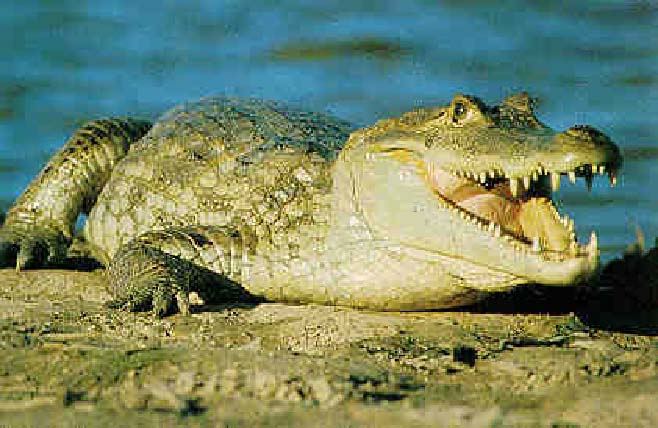Description
Taxonomy
| Kingdom | Phylum | Class | Order | Family | Genus |
|---|---|---|---|---|---|
| Animalia | Chordata | Reptilia | Crocodilia | Alligatoridae | Caiman |
Synonyms
Invasion History
Chesapeake Bay Status
| First Record | Population | Range | Introduction | Residency | Source Region | Native Region | Vectors |
|---|---|---|---|---|---|---|---|
| 1964 | Failed | Contracting | Introduced | Regular Resident | South America | South America | Ornamental(Pet Release) |
History of Spread
Caiman crocodilus (Common Caiman) is native to central and South America from southern Mexico to Argentina (Ross 1989). This crocodilian was widely sold in the pet trade as juvenile 'baby alligators'. It was apparently introduced to canals in the Miami FL area in the late 1950s, and was established by the 1960s (Butterfield et al. 1997). Currently, the breeding range of this species is from Lake Jessup in Seminole County, to Florida City, Dade county (Poss et al. 2000). Caiman crocodilus seems to be unable to tolerate temperatures below 12-15 C (Brandt and Mazzotti 1990), so that this species is unlikely to become established beyond Southern FL.
Scattered records of individual C. crocodilus are known in several U.S. states, including the region of Boston MA and the St. Johns river drainage FL, the lower Colorado Basin in AZ, the Central Valley of CA (Florida Caribbean Science Center 2001), all outside the species' thermal tolerance range. In the Chesapeake Bay region, there are at least 4 records of individual animals, from Lake Whitehurst in Norfolk VA, from a pond in eastern Henrico County VA, and from Fourmile Creek, Arlington VA (Mitchell 1994), and from ponds on the tidal Patapsco River, near Brooklyn Park (Roylance 2010). Breeding and overwintering of these creatures are extremely unlikely, unless they have access to warm effluents.
References- Brandt and Mazzotti 1990; Florida Caribbean Science Center 2001; Mitchell 1994; Poss 2000; Ross 1989
Invasion Comments
Ecology
Environmental Tolerances
| For Survival | For Reproduction | |||
|---|---|---|---|---|
| Minimum | Maximum | Minimum | Maximum | |
| Temperature (ºC) | 12.0 | |||
| Salinity (‰) | 0.0 | 0.0 | ||
| Oxygen | ||||
| pH | ||||
| Salinity Range | fresh-oligo |
Age and Growth
| Male | Female | |
|---|---|---|
| Minimum Adult Size (mm) | ||
| Typical Adult Size (mm) | ||
| Maximum Adult Size (mm) | ||
| Maximum Longevity (yrs) | ||
| Typical Longevity (yrs |
Reproduction
| Start | Peak | End | |
|---|---|---|---|
| Reproductive Season | |||
| Typical Number of Young Per Reproductive Event |
|||
| Sexuality Mode(s) | |||
| Mode(s) of Asexual Reproduction |
|||
| Fertilization Type(s) | |||
| More than One Reproduction Event per Year |
|||
| Reproductive Startegy | |||
| Egg/Seed Form |
Impacts
Economic Impacts in Chesapeake Bay
Except for the commotion generated by the discovery of a crocodilian in an urban area, Caiman crocodilus (Common Caiman) has no economic impacts in the Chesapeake Bay region, since it is incapable of surviving winter temperatures.
Economic Impacts Outside of Chesapeake Bay
Except for the commotion generated by the discovery of a crocodilian in urban areas, Caiman crocodilus (Common Caiman) has no economic impacts in the northern US, since it is incapable of surviving winter temperatures in the region (Brandt and Mazzotti 1990). Unsuccessful attempts have been made to eradicate C. crocodilus from southern FL. The extent of its economic impacts there are unclear (Poss 2000).
References: Brandt and Mazzotti 1990; Poss et al. 2000
Ecological Impacts on Chesapeake Native Species
Caiman crocodilus (Common Caiman) is a failed introduction to the Chesapeake Bay region, since it is incapable of surviving winter temperatures in the region. It has no significant impacts on native biota.
Ecological Impacts on Other Chesapeake Non-Native Species
Caiman crocodilus (Common Caiman) is a failed introduction to the Chesapeake Bay region, since it is incapable of surviving winter temperatures in the region. It has no significant impacts on other exotic biota.
References
Brandt, Laura A.; Mazzotti, Frank J. (1990) The behavior of juvenile Alligator mississippiensis and Caiman crocodilus exposed to low temperatures., Copeia 1990: 867-8911996 Nonindigenous Aquatic Species Database. http://nas.er.usgs.gov/
Mitchell, Joseph C. (1994) The Reptiles of Virginia., , Washington, D. C.. Pp.
1999 Nonindigenous species in the Gulf of Mexico.
Ross, Charles A (1989) Crocodiles and Alligators, , New York. Pp.
